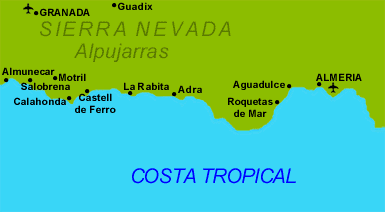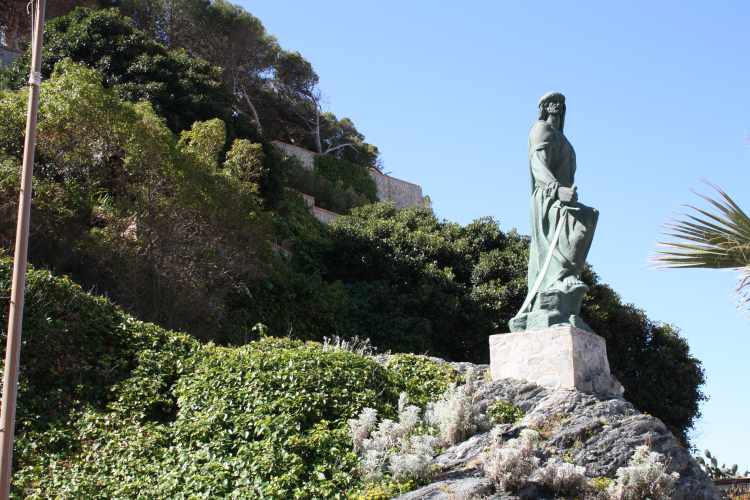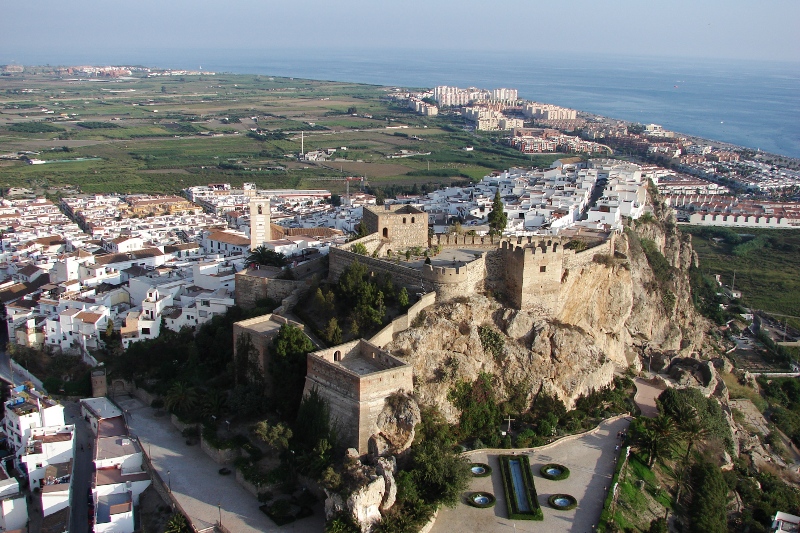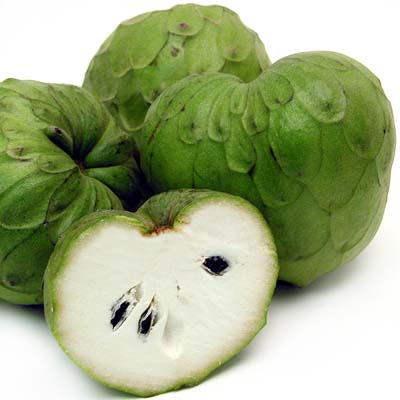
All along its 100 kilometres of coast, Granada has plenty to be proud of. In this strip of welcoming beaches and pristine coves, a warm and bountiful climate reigns, one of long, sunny days, long evenings and starlit nights. Christened the Tropical Coast, exotic fruits grow here such as the chirimoya, or custard-apple, which can only flourish at southerly latitudes. Boxed in between the provinces of Málaga and Almería, Granada's coast is scattered with towers and ancient fortresses that in another age acted as sentinels in a hostile and turbulent Mediterranean, a haunt of pirates and knaves. The villages appear as tiny white specks among the high hills and rugged valleys.
 12.15.10.png)
La Herradura was once a humble fishing village. Now it is a tourist centre between Cerro Gordo and Punta de la Mona. Its bay is host to naturist beaches such as Cantarriján and leisure ports such as Marina del Este, which in recent years has become a popular haven for scuba-diving enthusiasts.
The N-340 road acts as an umbilical cord between the coastal villages. From the La Herradura exit it passes curves, gradients, viewpoints and sheer ravines before arriving at Almuñécar. The oldest of the region's villages has its most identifiable postcard image in the form of the beach of San Cristóbal.
 The maritime drive continues between tall, leafy palm trees. On the way lies the bronze statue of Abderramán I, the Umayyad prince who disembarked one morning in the year 755 ready to make Cordoba the capital of Muslim Andalusia. He arrived in Almuñecar, which in previous centuries had welcomed the Phoenicians, attracted by the fishing and fruit of the fertile coast. Almuñécar was crowned by an Arab castle.
The maritime drive continues between tall, leafy palm trees. On the way lies the bronze statue of Abderramán I, the Umayyad prince who disembarked one morning in the year 755 ready to make Cordoba the capital of Muslim Andalusia. He arrived in Almuñecar, which in previous centuries had welcomed the Phoenicians, attracted by the fishing and fruit of the fertile coast. Almuñécar was crowned by an Arab castle.
The Archaeological Museum is in Cueva de los Siete Palacios. There is a bird park and footpaths leading inland towards the valley of the Río Verde, where the chirimoya plantations extend. The uphill route to the villages of Jete, Otívar and Lentegí is marked by farming cooperatives.
Though once woodland in which nothing grew except broom and holm oak, since the middle of the past century these valleys have been filled with medium-sized trees brought from different parts of the Americas. The three villages found in the valley of the Río Grande are small and have Morisco churches.
Salobreña is the most beautiful village on the Tropical Coast. Its houses are white, a dazzling white. It is crowned by an Arab fortress and surrounded by a tortuous, narrow network of streets. Its neighbourhoods carry the names of Albayzín, El Brocal and La Fuente. Among these towers the campanile of the Mudejar church of the Virgen del Rosario.

Further along you come across Motril. Granada's second most populous city lies inland, in the heart of a fertile plain surrounded by impregnable mountains. The fields of crops that reach towards the sandy line of the sea are sowed with mango, banana, avocado, chirimoya, papaya and guava.
The tree-lined avenues lead to the hill where the shrine of Nuestra Señora de la Cabeza is sited. Centuries ago, this place was the palace of retreat for the sultana Aixa, mother of Boabdil, the last Arab king of Granada. At the foot of the shrine is spread the park of the Pueblos de America. The Church of the Incarnation is Mudejar and the Casa de la Palma, an old sugar refinery of Arabic origin, is today a cultural centre.
Here ends this route, which brings together the fertility and the grandeur of the mountains, which are constantly leaning towards the sea.
 Granada's Tropical Coast lies trapped between the foothills of the southern Sierra Nevada and the Mediterranean. It therefore produces a unique climate, hence the name of the coast in this area.
Granada's Tropical Coast lies trapped between the foothills of the southern Sierra Nevada and the Mediterranean. It therefore produces a unique climate, hence the name of the coast in this area.
The star of its subtropical crops is the chirimoya or custard-apple, a green, heart-shaped fruit with ivory-white flesh, which leaves a soft, somewhat sweet taste on the palate.
The fruit is native to southern Ecuador and northern Peru; the first Spanish explorers to reach these lands were those who brought it to Europe.
The indigenous varieties of Fino de Jete and Campas are those that benefit from the status of Protected Designation of Origin.
It provides an average of 103 kcal per fruit.
20% of its weight is made up of carbohydrates in the form of sugars. Rich in calcium, vitamin C and fibre, it helps intestinal movement.
The cuisine of Granada's Tropical Coast is mostly determined by its fruit. The chirimoya, the avocado, the mango and the guava are exotic fruits that have been used to make delicious salads for some decades now. They are usually accompanied by other fruits such as kiwis, heart of palm, strawberries, pears and apples. The Tropical Coast is a pleasure to all the senses but especially sight and taste.